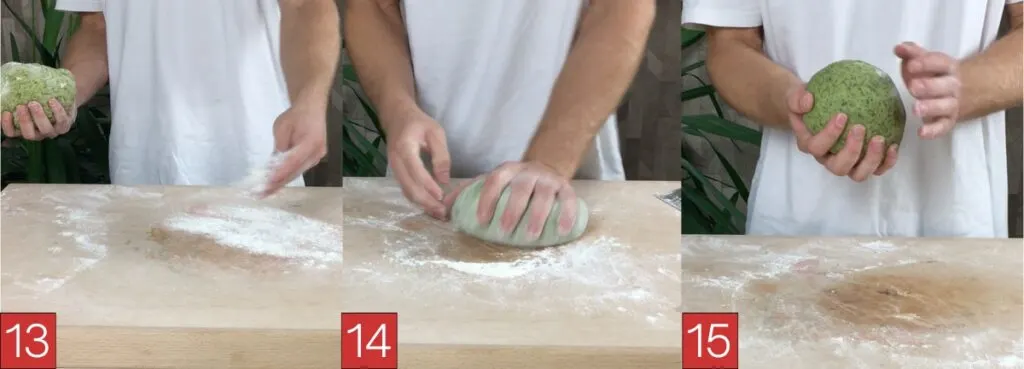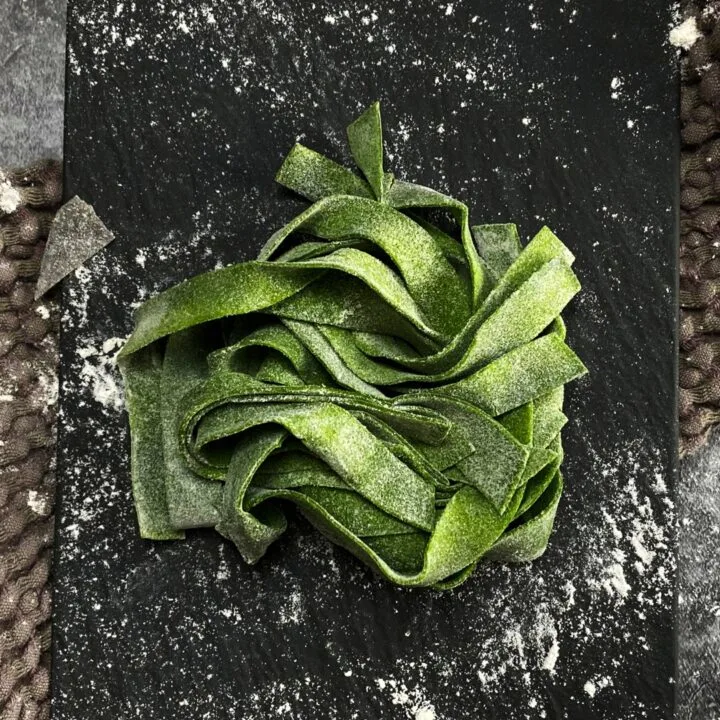This article will teach you how to make bright-green homemade spinach pasta step by step.
This basic recipe is perfect for tagliatelle and pappardelle, but you can also use it for other types of pasta, such as fusilli, trofie, or stuffed tortellini.
First, I’ll show you how to make tagliatelle with spinach dough and which traditional recipes go perfectly with it.
Then you’ll find instructions for more advanced types of pasta, as well as tips for cooking, storing, and drying pasta with spinach.
⬇ Pin it for later!

How to Make Spinach Pasta at Home (By Hand)
Pasta dough with spinach is a common variation of the classic egg dough in Italy. Often this green dough is rolled out into pasta sheets and used for homemade lasagna or cannelloni.
Spinach pasta is a welcome variation to regular pasta and requires a little extra effort.
Best Recipe for Spinach Pasta:
4 Servings
- 8 Ounces (250 g) fresh spinach or 2.3 ounces (65 g) frozen spinach
- Five large eggs without shells (8 ounces or 250 g)
- 16 ounces (455 g) of all-purpose flour or Italian wheat flour Tipo 00
(Find my exact product recommendations in the recipe card)
Tipo 00 Italian flour is typically used for this recipe, but it is not available everywhere. As a substitute, you can easily use commercial wheat flour type 405, whose properties are comparable.
In addition to this basic recipe, there are several variations that you can use to achieve more bite or even better elasticity, for example. You can find the different recipes in the following article:
Step 1: Boil the spinach for 3 minutes, cool, and squeeze out the water.
First, I cook the spinach for about three minutes, covered with a lid. Then I let the spinach cool to wring out the water with my hands.
Please do not put the spinach in ice water to cool it down! If you do, the spinach will no longer give its color to the egg mixture, and your dough will end up yellowish with green spots (from the chopped spinach).

Step 2: Put in blender with eggs and puree.
Make sure the spinach contains almost no liquid because the eggs already carry a high liquid content.
Mix the spinach and eggs for 1 to 2 minutes to get a bright green and homogeneous mixture.
Now you have laid the foundation for a gorgeous spinach dough.

Step 3: Empty the flour onto the work surface, pour the egg and spinach mixture into the well, and mix.
The following steps are the same as making classic pasta dough.
First, I empty the flour onto the work surface and form a hollow about 15 centimeters wide with a 1-centimeter thick bottom from 400 grams of flour.
Then I sprinkle in the salt and the eggs.
With a fork, I gradually incorporate the flour from the outer wall and the bottom of the flour without creating an opening.

Step 4: Work in all the flour with the dough scraper and then form a lump with your hands.
Once a “mushy” mass is formed, I run the dough scraper under the flour base from each side and fold it over the well. I then pass the mixture through several times, creating a crumbly dough.
Next, I scrape any flour residue from my dough scraper and continue with my hands. Then, I press the dough crumbs together into a clump.
You can sprinkle in some additional water if the mixture is still crumbly.

Step 5: Knead for at least 10 minutes, adding a little flour if necessary.
There are several kneading techniques, one of which I find particularly compelling:
Apply forward pressure to the dough with the heel of your hand. Then, pull the dough back again with the other hand, turning it slightly by about 45°. Repeat the process until all the dough crumbs are incorporated.
Knead the dough for at least 8 minutes or until the surface feels silky and no longer sticks.
If the dough still sticks to your hands, you need to sprinkle flour on the work surface and work it in.

Step 6: Wrap the finished pasta dough in plastic wrap and let it rest at room temperature for 30 minutes
Once the pasta dough has the right consistency, you can wrap it in plastic and rest it for 30 minutes.
The resting time is crucial because it rearranges the protein chains responsible for the dough’s stretchiness. This is especially important if you want to thinly roll out the pasta dough.
You have successfully made spinach dough!
Now you can process the dough into different pasta shapes and use them for the most delicious dishes.
Before I show you which shapes I created with this dough, let’s look at three popular variations for this recipe.

Step 7: Roll out into a 1-millimeter thin pasta sheet.
When I use 400 to 600 grams of flour, I cut the dough in half because it’s easier to work with that way.
I then press the dough half flat with the heel of my hand and roll it out paper-thin with a rolling pin.
The dough sheet should be at most 1 millimeter for ribbon noodles. A good indicator that you reached the required thickness is when the work surface becomes visible through the dough.
Here is how you can roll out the dough:
Place the rolling pin in the center of the dough disk and stretch it forward in a short, wave-like motion.
Then rotate the disc about 45 degrees and repeat the process. If the dough sticks, sprinkle it with a bit of flour.
Tip: as soon as the dough disk is somewhat larger, pull it towards you across the work surface so that a third protrudes. It makes it easier on your back because you don’t have to lean so far forward. On top of that, the dough stretches more quickly due to gravity.

Step 8: Fold the pasta dough several times and cut it into strips.
You completed a significant part of the work. Now you have to shape the noodles.
To make ribbon noodles, fold the dough into itself several times. It makes it easy to get evenly shaped noodles.
Tip: I let the dough dry on both sides for about 5 minutes before folding it. This way, I ensure that the noodles can be formed into nests afterward without sticking together.
If the dough sheet is still sticky, sprinkle it with flour. Otherwise, the noodles will weld together when you cut them, and you’ll have to separate them individually by hand.

With a sharp knife, I divide the pasta at regular intervals (about 1 centimeter for tagliatelle).
Lastly, a little trick: before you cut the pasta, turn the pasta sheet so that one end is facing up. It will make it easier to form the pasta nests because you can grab the tagliatelle all at once (see Figure 24).

Step 9: Grab the ends of each noodle and form nests out of them.
Whether you want to dry the pasta, freeze it, or use it right away: Forming pasta nests is the best way to store them temporarily to save space.
Hold the ends of the pasta in one hand and wrap the pasta once around with the other hand, as shown in the pictures.

You get mouth-watering green tagliatelle!
Beautiful.

Now you have several options. You can:
- Cook the homemade pasta
- Freeze the fresh pasta
- Dry the pasta and store it for a long time
Note that fresh pasta cooks much faster than dried. Usually, 2 to 3 minutes is enough.


Best Homemade Spinach Pasta (Step by Step)
This article will teach you how to make bright-green homemade spinach pasta step by step.
This basic recipe is perfect for tagliatelle and pappardelle, but you can also use it for other types of pasta, such as fusilli, trofie, or stuffed tortellini.
First, I'll show you how to make tagliatelle with spinach dough and which traditional recipes go perfectly with it.
Then you'll find instructions for more advanced types of pasta, as well as tips for cooking, storing, and drying pasta with spinach.
Ingredients
- 8 Ounces (250 g) fresh spinach or 2.3 ounces (65 g) frozen spinach
- Five large eggs without shells (8 ounces or 250 g)
- 16 ounces (455 g) of all-purpose flour or Italian wheat flour Tipo 00
Instructions
- Boil the spinach for 3 minutes, let it cool and squeeze out the water
- Put in blender with eggs and puree
- Empty the flour onto the work surface, pour the egg and spinach mixture into the well, and mix with a fork
- Work in all the flour with the dough scraper and then form a lump of dough with your hands
- Knead for at least 10 minutes, adding a little flour if necessary
- Wrap the finished pasta dough in plastic wrap and let it rest at room temperature for 30 minutes
- Roll out into a 1-millimeter thin pasta sheet.
- Fold the pasta dough several times and cut it into strips.
- Grab the ends of each noodle and form nests out of them.
Nutrition Information:
Yield: 4 Serving Size: 1Amount Per Serving: Calories: 2171Total Fat: 13gSaturated Fat: 3gTrans Fat: 0gUnsaturated Fat: 7gCholesterol: 233mgSodium: 424mgCarbohydrates: 431gFiber: 26gSugar: 4gProtein: 78g
